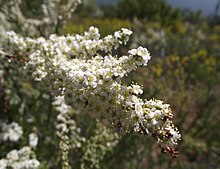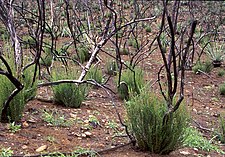| Adenostoma | |
|---|---|

| |
| Adenostoma fasciculatum in flower | |
|
Scientific classification
| |
| Kingdom: | Plantae |
| Clade: | Tracheophytes |
| Clade: | Angiosperms |
| Clade: | Eudicots |
| Clade: | Rosids |
| Order: | Rosales |
| Family: | Rosaceae |
| Subfamily: | Amygdaloideae |
| Tribe: | Sorbarieae |
| Genus: |
Adenostoma Hook. & Arn. |
Adenostoma is a genus of shrubs in the Rose family ( Rosaceae) containing only two species, chamise ( Adenostoma fasciculatum) and redshanks ( Adenostoma sparsifolium). Both are native to the Californias.
Description
Characteristics
The plants grow in a habit of shrubs to small trees, and the stem is more or less resinous. [1] Both species in this genus feature stiff, linear leaves arranged alternately or in clusters along stems with shredding bark. Flowers form on a panicle, are cream to white and, as in all members of the rose family, have hypanthia. [2] The fruit is an achene. Chromosome number is 2n = 18. [1]
Distribution and habitat
Both species are native to coastal California and Baja California. Adenostoma fasciculatum is also native to California in the Sierra Nevada. [2] They are found in plant communities and sub-ecoregions of the California chaparral and woodlands ecoregion.
Taxonomy
- Species of Adenostoma
-
Adenostoma sparsifolium Torr. - Redshanks
Phylogenetic analysis places Adenostoma closest to Chamaebatiaria and Sorbaria, and suggests tentative placement in the subfamily Spiraeoideae, tribe Sorbarieae. [3] The name Adenostoma comes from Greek, meaning "glandular mouth," referring to the hypanthium ring gland. [1]
References
- ^ a b c Jones, William (2012). "Adenostoma". Jepson eFlora. Jepson Flora Project (eds.). Archived from the original on 2015-12-18. Retrieved 18 December 2021.
- ^ a b Jepson Manual, University of California, 1993; Adenostoma
- ^ Montalvo, A.M.; Riordan, E.C.; Beyers, Jan (2017). "Plant profile for Adenostoma fasciculatum" (PDF). Treesearch. United States Department of Agriculture. Archived (PDF) from the original on 2020-03-19. Retrieved 15 October 2021.
External links

